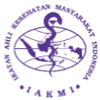OVERVIEW OF ADOLESCENTS MENTAL HEALTH STATUS DURING THE COVID-19 PANDEMIC IN INDONESIA: A CROSS-SECTIONAL STUDY
Downloads
Background: There has been a steady rise in the number of teenagers who are reporting mental health issues. Empirical evidence confirms a significant increase in mental health services in Yogyakarta between 2018 and 2022. The efforts to prevent and control mental health issues are extensive and all-encompassing, with one approach being the early identification of mental health problems in teenagers. Purpose: The purpose of this study is to assess the mental health levels of teenagers during the COVID-19 epidemic. Methods: This study used a quantitative descriptive methodology, encompassing a sample of 64 adolescents residing in Warungboto Village, Yogyakarta City, aged between 15 and 24 years. The participants were chosen according to the prevalence of adolescents in the research area. The utilised instruments included the Depression Anxiety and Stress Scale (DASS-21) and the Perceived Stress Scale (PSS-10), which were subjected to descriptive processing. Results: 56% of participants identified as male, while 61% fell within the age bracket of 19-24 years. Furthermore, a significant majority (97%) of respondents actively pursued education beyond the secondary level. The DASS-21 assessment revealed a highly pronounced level of anxiety (26.6%), a typical level of depression (35.9%), and a moderate degree of stress (18.8%). In addition, the PSS-10 findings indicated that 59% of adolescents encountered stress. Conclusion: Adolescents are a very susceptible demographic to mental health issues, particularly anxiety. Regular and timely screenings are necessary to prevent the progression of severity, especially in mild or moderate conditions.
Akat, M., & Karataş, K. 2020. Psychological Effects of COVID-19 Pandemic on Society and Its Reflections on Education. Journal of Turkish Studies, 15(4), 1–13. https://doi.org/10.7827/turkishstudies.44336.
Alonso, J. et al. 2018. World Mental Health Surveys in 21 countries. Depress Anxiety, 35(3), 1–24. https://doi.org/10.1002/da.22711.Treatment.
Andayani, B., & Koentjoro. (2004). Psikologi Keluarga: Peran Ayah Menuju Coparenting. Surabaya: Citra Media.
Bandelow, B., & Michaelis, S. 2015. Epidemiology of anxiety disorders in the 21st century. Seminars in Fetal and Neonatal Medicine, 20(6), 377. https://doi.org/10.1016/j.siny.2015.10.004.
Barseli, M., & Ifdil, I. 2017. Konsep Stres Akademik Siswa. Jurnal Konseling dan Pendidikan, 5(3), 143–148. https://doi.org/10.29210/119800
Caffo, E., Asta, L., & Scandroglio, F. 2021. Predictors of mental health worsening among children and adolescents during the coronavirus disease 2019 pandemic. Current Opinion in Psychiatry, 34(6), 624–630. https://doi.org/10.1097/YCO.0000000000000747.
Center for research and development of public health efforts. 2015. Health Risk Behavior in Junior and High School Students (Results of the National Survey of School-Based Health in Indonesia). Research and development agency of the Indonesian Ministry of Health.
Colizzi, M., Lasalvia, A., & Ruggeri, M. 2020. Prevention and early intervention in youth mental health: Is it time for a multidisciplinary and trans-diagnostic model for care?. International Journal of Mental Health Systems, 14(1), 1–14. https://doi.org/10.1186/s13033-020-00356-9.
Courtney, D., Watson, P., Battaglia, M., Mulsant, B. H., & Szatmari, P. 2020. COVID-19 Impacts on Child and Youth Anxiety and Depression: Challenges and Opportunities. Canadian Journal of Psychiatry, 65(10), 688–691. https://doi.org/10.1177/0706743720935646.
Deighton, J., Lereya, S. T., Casey, P., Patalay, P., Humphrey, N, & Wolpert, M. 2019. Prevalence of mental health problems in schools: Poverty and other risk factors among 28 000 adolescents in England. British Journal of Psychiatry, 215(3), 565–567. https://doi.org/10.1192/bjp.2019.19.
Desouky, D. E. S., Ibrahem, R. A., & Omar, M. S. 2015. Prevalence and comorbidity of depression, anxiety and obsessive compulsive disorders among Saudi secondary school girls, Taif Area, KSA. Archives of Iranian Medicine, 18(4), 234–8. https://pubmed.ncbi.nlm.nih.gov/25841944/.
Dianovinina, K. 2018. Depresi pada Remaja : Gejala dan Permasalahannya. Psikogenesis, 6(1), 69–78. https://doi.org/10.24854/jps.v6i1.634
Dinas Kesehatan Kota Yogyakarta. 2013. Profil Kesehatan Kota Tahun 2013, Yogyakarta: Dinas Kesehatan Kota Yogyakarta.
El-Sherbiny, N. A., & Elsary, A. Y. 2022. Smoking and nicotine dependence in relation to depression, anxiety, and stress in Egyptian adults: A cross‑sectional study. Journal of Family and Community Medicine, 29(1), 8–16. https://doi.org/10.4103/jfcm.jfcm.
Emilda, F., Machira, C., & Wahab, A. 2016. Parent-Adolescent Familiarity and Depression in High School Teenagers in the City of Yogyakarta. Berita Kedokteran Masyarakat (BKM Journal of Community Medicine and Public Health), 32(10), 379–384. https://doi.org/10.22146/bkm.8184
Falissard, B. 2016. Early detection of child and adolescent mental disorders: some elements of a necessary debate. European Child and Adolescent Psychiatry, 25(10), 1041–1043. https://doi.org/10.1007/s00787-016-0906-6.
Golberstein, E., Gonzales, G., & Meara, E. 2019. How do economic downturns affect the mental health of children? Evidence from the National Health Interview Survey. Health Economics (United Kingdom), 28(8), 955–970. https://doi.org/10.1002/hec.3885.
Jiao, W. Y., Wang, L. N., Liu, J., Fang, S. F., Jiao, F. Y., Mantovani, M. P., & Somekh, E. 2020. Behavioral and Emotional Disorders in Children during the COVID-19 Epidemic. The Journal of Pediatrics, 2(1), 1–12. https://doi.org/10.1016/j.jpeds.2020.03.013.
Kurniawati, N. W. W. & Suarya, L. M. K. S. 2019. Gambaran Kecemasan Remaja Perempuan dengan Berat Badan Berlebih. Psikologi Udayana, 6(2), 280–290. https://doi.org/10.24843/JPU.2019.v06.i02.p07
Loades, M. E., DClinPsy., Chatburn, E., Sweeney, N. H., Reynolds, S., Shafran, R., Brigden, A., Linney, C., McManus, M. N., Borwick, C., & Crawley, E. 2020. Rapid systematic review: The impact of social isolation adolescents in the context of COVID-19. Journal of the American of Child & Adolescent Psychiatry, 59(11), 1218–1239. https://doi.org/10.1016/j.jaac.2020.05.009
Masten, A. S., & Motti-Stefanidi, F. 2020. Multisystem Resilience for Children and Youth in Disaster: Reflections in the Context of COVID-19. Adversity and Resilience Science, 1(2), 95–106. https://doi.org/10.1007/s42844-020-00010-w.
Ministry of Health Republic of Indonesia. 2014. Adolescent Reproductive Health Situation. Jakarta: Data and Information Center of the Indonesian Ministry of Health.
Ministry of Health Republic of Indonesia. 2018. The Basic Health Research 2018. Jakarta: Ministry of Health Republic of Indonesia.
Miranda-Mendizabal, A., Castellví, P., Parés-Badell, O., Alayo, I., Almenara, J., Alonso, I., Blasco, M. J., Cebrià, A., Gabilondo, A., Gili, M., Lagares, C., Piqueras, J. A., Rodríguez-Jiménez, T., Rodríguez-Marín, J., Roca, M., Soto-Sanz, V., Vilagut, G., & Alonso, J. 2019. Gender differences in suicidal behavior in adolescents and young adults: systematic review and meta-analysis of longitudinal studies. International Journal of Public Health, 64(2), 265–283. https://doi.org/10.1007/s00038-018-1196-1
Musradinur. 2016. Stres dan Cara Mengatasinya dalam Perspektif Psikologi. Edukasi, 2(2), 183–200. https://doi.org/10.22373/je.v2i2.815
Panchal, U., Salazar de Pablo, G., Franco, M., Moreno, C., Parellada, M., Arango, C., & Fusar-Poli, P. 2023. The impact of COVID-19 lockdown on child and adolescent mental health: systematic review. European Child and Adolescent Psychiatry, 32(7), 1151–1177. https://doi.org/10.1007/s00787-021-01856-w
Panda, P. K., Gupta, J., Chowdhury, S. R., Kumar, R., Meena, A. K., Madaan, P., Sharawat, I. K., & Gulati, S. 2021. Psychological and Behavioral Impact of Lockdown and Quarantine Measures for COVID-19 Pandemic on Children, Adolescents and Caregivers: A Systematic Review and Meta-Analysis. Journal of Tropical Pediatrics, 67(1), 1–13. https://doi.org/10.1093/tropej/fmaa122
Purnomosidi, F., Ernawati, S., Riskiana, D., & Indriyani, A. 2023. Kesehatan Mental Pada Remaja. Jurnal Pengabdian Kepada Masyarakat, 2(1), 1-7. https://doi.org/10.54066/abdimas.v2i1.257
Racine, N., McArthur, B. A., Cooke, J. E., Eirich, R., Zhu, J., & Madigan, S. 2021. Global Prevalence of Depressive and Anxiety Symptoms in Children and Adolescents during COVID-19: A Meta-analysis. JAMA Pediatrics, 175(11), 1142–1150. https://doi.org/10.1001/jamapediatrics.2021.2482.
Rahmayanti, Y. E., & Rahmawati, T. 2018. Hubungan Dukungan Keluarga Dengan Kejadian Depresi Pada Remaja Awal. Asuhan Ibu dan Anak, 3(2). https://doi.org/10.33867/jaia.v3i2.87
RKPD Kota Yogyakarta. 2015. Peraturan Walikota Yogyakarta tentang Rencana Kerja pembangunan Daerah Kota Yogyakarta tahun 2015, Kota Yogyakarta.
Saha, I., Majumder, J., Bagepally, B. S., Ray, S., Saha, A., & Chakrabarti, A. 2023. Burden of mental health disorders and synthesis of community-based mental health intervention measures among adolescents during COVID-19 pandemic in low middle-income countries: A systematic review and meta-analysis. Asian Journal of Psychiatry, 89(November 2023), 103790. https://doi.org/https://doi.org/10.1016/j.ajp.2023.103790.
Santrock, J. W. 2007. Remaja edisi kesebelas. Jakarta: Erlangga.
Sarwono, S. 2012. Pengantar Psikologi Umum. Jakarta: Rajawali Pers.
Sheets, E. S., & Craighead, W. E. 2014. Comparing chronic interpersonal and noninterpersonal stress domains as predictors of depression recurrence in emerging adults. Behaviour Research and Therapy, 63, 36–42. https://doi.org/10.1016/j.brat.2014.09.001
Vellyana, D., Lestari, A., & Rahmawati, A. 2017. Faktor-faktor yang Berhubungan dengan Tingkat Kecemasan pada Pasien Preoperative di RS Mitra Husada Pringsewu. Kesehatan, 8(1), 108–113. https://doi.org/10.26630/jk.v8i1.403
Wicaksono, T., Eko., & Yuwono, S. 2016. Perbedaan Hardiness pada Mahasiswa Universitas Muhammadiyah Surakarta Ditinjau dari Keikutsertaan Organisasi. Universitas Muhammadiyah Surakarta.
Wijaya, A., Purnomolastu, N., & Tjahjoanggoro, A. 2015. Kepemimpinan Berkarakter. Surabaya: Brilian Internasional.
World Health Organization (WHO). 2020. Depression. https://www.who.int/news-room/fact-sheets/detail/depression
World Health Organization (WHO). 2021. Adolescent mental health, 17 November 2021. https://www.who.int/news-room/fact-sheets/detail/adolescent-mental-health.
Wuon, A.S., Bidjuni, H., & Kallo, V. 2016. Perbedaan Tingkat Depresi pada Remaja yang Tinggal Wanea Manado. Keperawatan, 4(2).
Zhou, X., Zhang, Y., Furukawa, T. A., Cuijpers, P., Pu, J., Weisz, J. R., Yang, L., Hetrick, S. E., Del Giovane, C., Cohen, D., James, A. C., Yuan, S., Whittington, C., Jiang, X., Teng, T., Cipriani, A., & Xie, P. 2019. Different Types and Acceptability of Psychotherapies for Acute Anxiety Disorders in Children and Adolescents: A Network Meta-analysis. JAMA Psychiatry, 76(1), 41–50. https://doi.org/10.1001/jamapsychiatry.2018.3070

This work is licensed under a Creative Commons Attribution-NonCommercial-ShareAlike 4.0 International License.
Copyright of the article is transferred to the journal, by the knowledge of the author, whilst the moral right of the publication belongs to the author. In order to be accepted and published by JPH RECODE, author(s) submitting the article manuscript should complete all the review stages. By submitting the manuscript, the author(s) agreed to these following terms:
The copyright of accepted articles shall be assigned to JPH RECODE as the publisher of the journal. The intended copyright includes the rights to publish articles in various forms (including reprints). JPH RECODE maintain the publishing rights to the published articles.
Authors are permitted to disseminate published article by sharing the link/DOI of the article at JPH RECODE. Authors are allowed to use their articles for any legal purposes deemed necessary without written permission form JPH RECODE with an acknowledgement of initial publication to this journal.
The Copyright Transfer Agreement Form can be downloaded ON THIS FORM.





















